Key takeaways:
- Misinformation thrives on emotional responses and social media algorithms, creating echo chambers that distort reality.
- Critical thinking and media literacy are essential for recognizing and combating the effects of misinformation, particularly in political contexts.
- Engaging in discussions and verifying information through credible sources can help prevent the spread of falsehoods and improve public discourse.
- Personal experiences highlight the importance of skepticism and verification before sharing information online to maintain credibility and trust.
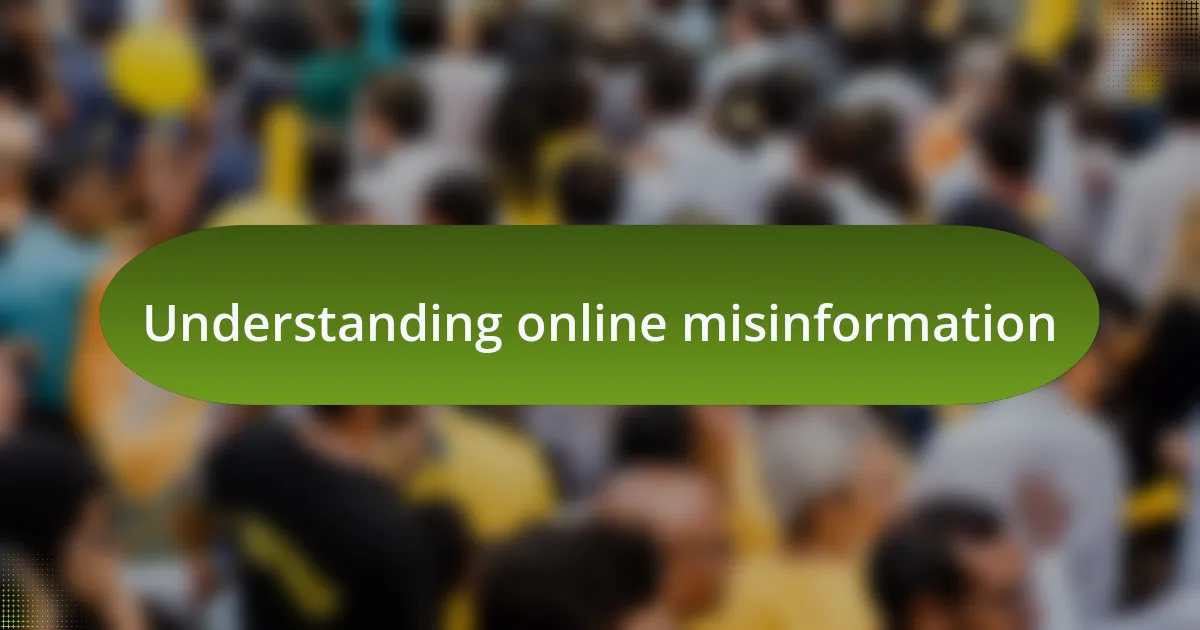
Understanding online misinformation
When I first encountered online misinformation, I was shocked by how easily it spreads. It’s like being caught in a web of half-truths designed to provoke outrage and confusion. Why do we often choose to believe what aligns with our beliefs over verified facts? This question still lingers in my mind, highlighting the emotional connection we have with information.
I remember reading a viral post that resonated deeply with my views, only to later realize it was based on misleading statistics. The feeling of betrayal can be profound, as if someone has taken a piece of my reality and twisted it. This experience taught me that misinformation often feeds on our emotions—fear, anger, or even hope. It’s a powerful reminder that we must approach our news consumption with both curiosity and skepticism.
Understanding online misinformation requires us to acknowledge the role of social media algorithms, which often amplify sensational content. In my experience, this creates echo chambers where false narratives flourish. Reflecting on this, I can’t help but wonder: Are we not only consumers of information but also unwitting participants in its dissemination? It’s a sobering thought that compels us to think more critically about the sources we trust.
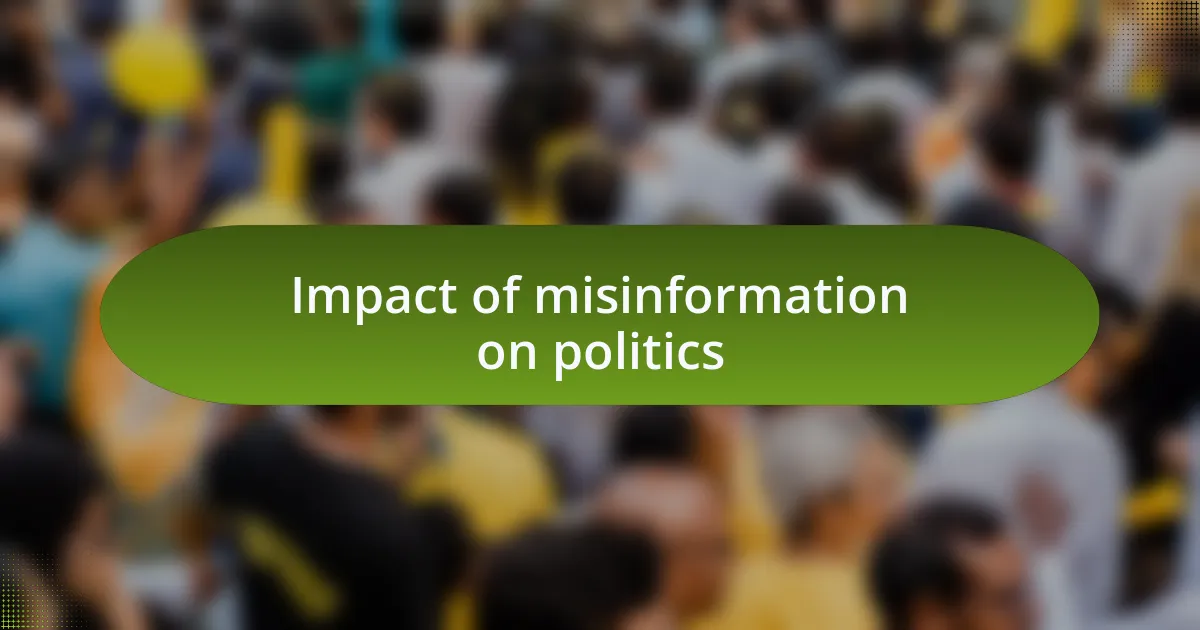
Impact of misinformation on politics
Misinformation’s impact on politics can be truly staggering. I recall a time during an election cycle when a misreported scandal dominated headlines, swaying public opinion and influencing voter behavior. It made me question how something so easily disproven could become a cornerstone of political debate, showcasing the fragility of informed citizenship.
When I engage with friends about political events, I often see how misinformation colors their perceptions. I recently found myself in a heated discussion over a false claim that was circulating prominently. The frustration of trying to clear up misconceptions felt like shouting into a void, illustrating just how entrenched these falsehoods can become and the real damage they do by eroding trust in legitimate sources.
Sometimes, I wonder whether we’ve become so desensitized to misinformation that we forget its consequences. Politics shouldn’t feel like a game of telephone, yet the way misinformation distorts facts creates a narrative that’s hard to untangle. In reflecting on this, I realize the urgent need for critical thinking and media literacy, as it’s crucial for restoring faith in our democratic processes.
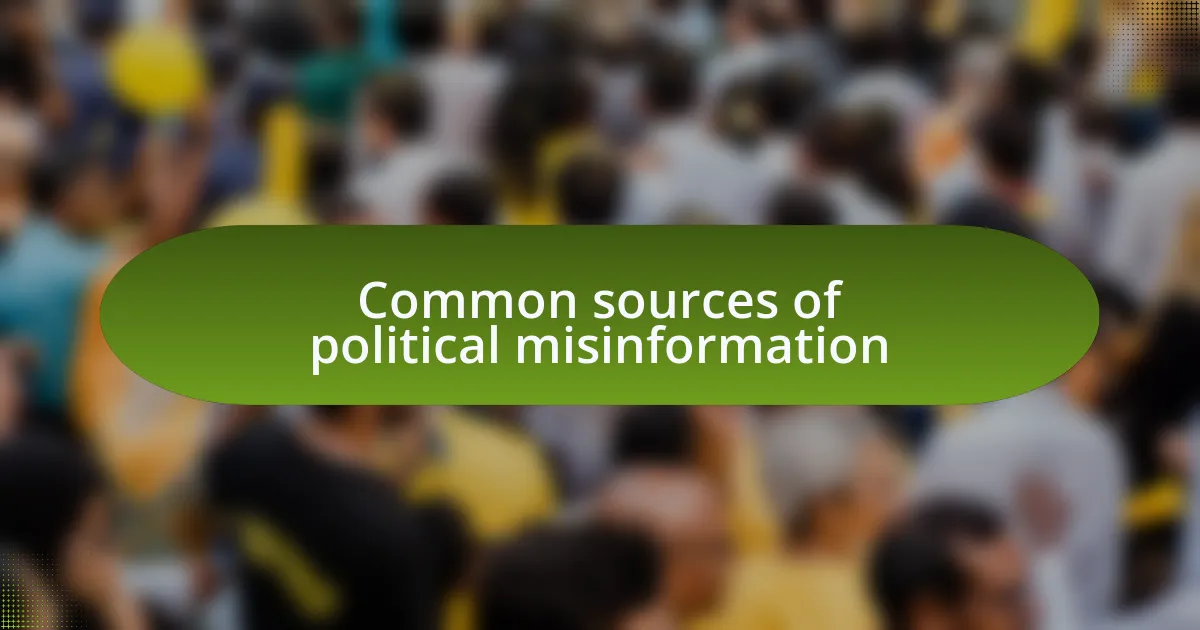
Common sources of political misinformation
When I dive deeper into the origins of political misinformation, I often encounter social media as a primary source. It’s fascinating—and somewhat alarming—how a tweet or a Facebook post can escalate into a widespread belief, sometimes within hours. I remember coming across a viral meme that twisted statistics to support a political argument; it spread like wildfire among my circle, making me wonder how well our critical filters hold up in the face of catchy content.
Another significant source I’ve noticed is sensationalist news outlets. These platforms often prioritize clicks over truth, leading to inflated headlines that grab attention but mislead readers. I’ve experienced the frustration of seeing a headline that sounds outrageous, only to realize upon reading the full article that the story lacks substantial evidence—leaving me questioning how many others rush to share without digging deeper.
Finally, consider the role of echo chambers in fueling misinformation. We often gravitate towards sources that reinforce our beliefs, creating a feedback loop that can distort reality. I once realized that a group I was part of heavily relied on a single news source that consistently presented a skewed narrative. It struck me how easy it is to become trapped in a bubble, questioning whether genuine discourse is possible when we surround ourselves with voices that only echo our own thoughts.
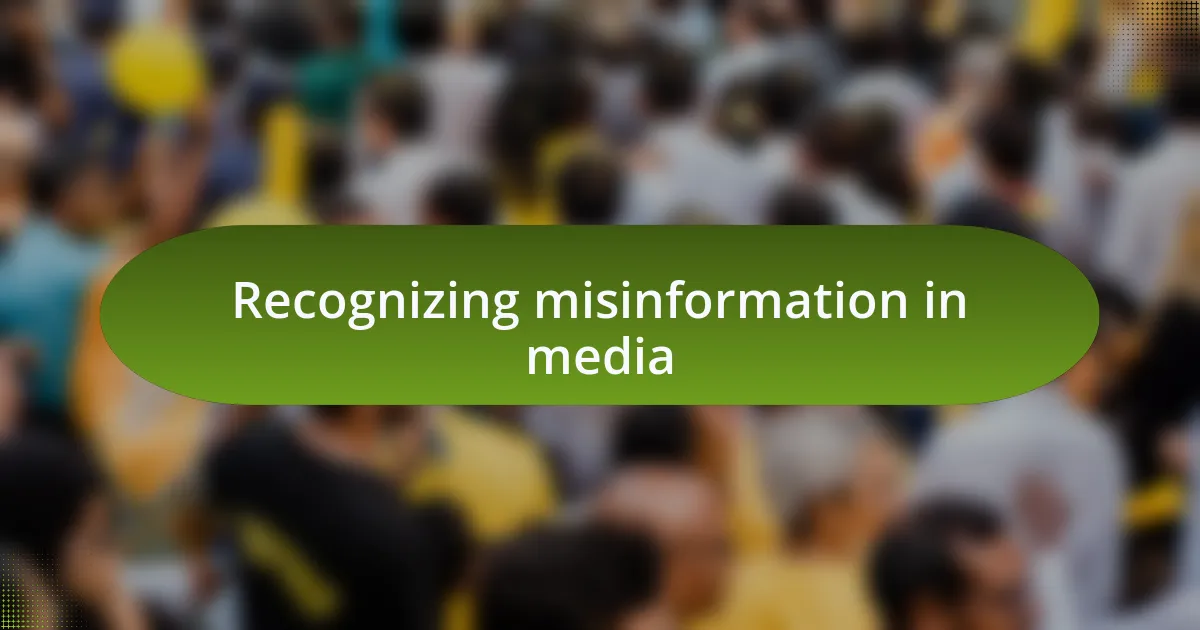
Recognizing misinformation in media
When it comes to recognizing misinformation in media, one of the first clues I look for is the presence of sensational language. I recall scrolling through a news site and stumbling upon an article that claimed a political figure was “destroying democracy” in bold letters. It made me stop and think—how often do we see language like this that aims to provoke outrage rather than inform? This kind of rhetoric often hints that the content may be more about evoking a response than delivering facts.
Additionally, I’ve learned to examine the sources quoted in articles. A few months ago, I encountered a piece that cited a so-called expert, only to find that this expert had little to no credibility in the field they were discussing. That moment reinforced my understanding: the validity of the source can dramatically impact the reliability of the information. Have you ever caught yourself sharing something that sounded right but crumbled under scrutiny? It’s a common experience that highlights the importance of scrutinizing who is being quoted.
Visual content also plays a significant role in spreading misinformation. I once shared an eye-catching infographic that claimed to depict voting statistics, only to later discover it was misleading, using outdated or cherry-picked data. This experience taught me how easily visuals can shape perceptions, prompting me to always verify the facts behind the graphics I encounter. Isn’t it troubling how a simple image can mislead us just as much as words can?
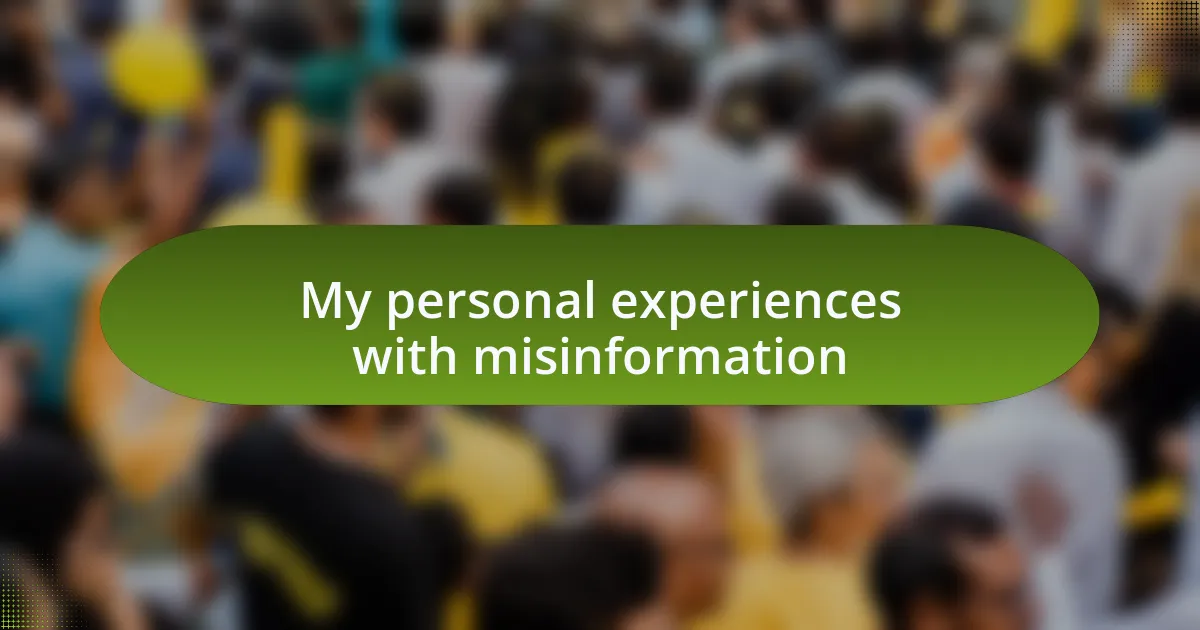
My personal experiences with misinformation
It was a couple of years ago when I first experienced the sting of misinformation firsthand. I shared a post on social media about a proposed policy change, thinking I was helping to raise awareness. To my dismay, a friend reached out to point out that the article was riddled with inaccuracies. That moment was a wake-up call—how often do we trust our instincts without verifying the facts first?
I vividly remember a late-night discussion with friends around a table, buzzing with opinions about a trending political issue. One friend passionately recounted a story based on a viral video, which later turned out to be completely fabricated. The frustration was palpable; we had all been so eager to partake in the debate that we’d overlooked verifying the truth. It made me question: how often do we let our emotions cloud our judgment, especially when it comes to hot-button topics?
Perhaps one of the most unsettling experiences was when I received an email claiming to offer insider information about an upcoming election. I was intrigued and almost took the bait until I decided to dig deeper. It didn’t take long to uncover that the email was a well-crafted phishing attempt. This incident left me feeling violated, as though I’d narrowly avoided a trap. Isn’t it alarming to think how easily and insidiously misinformation can invade our lives?
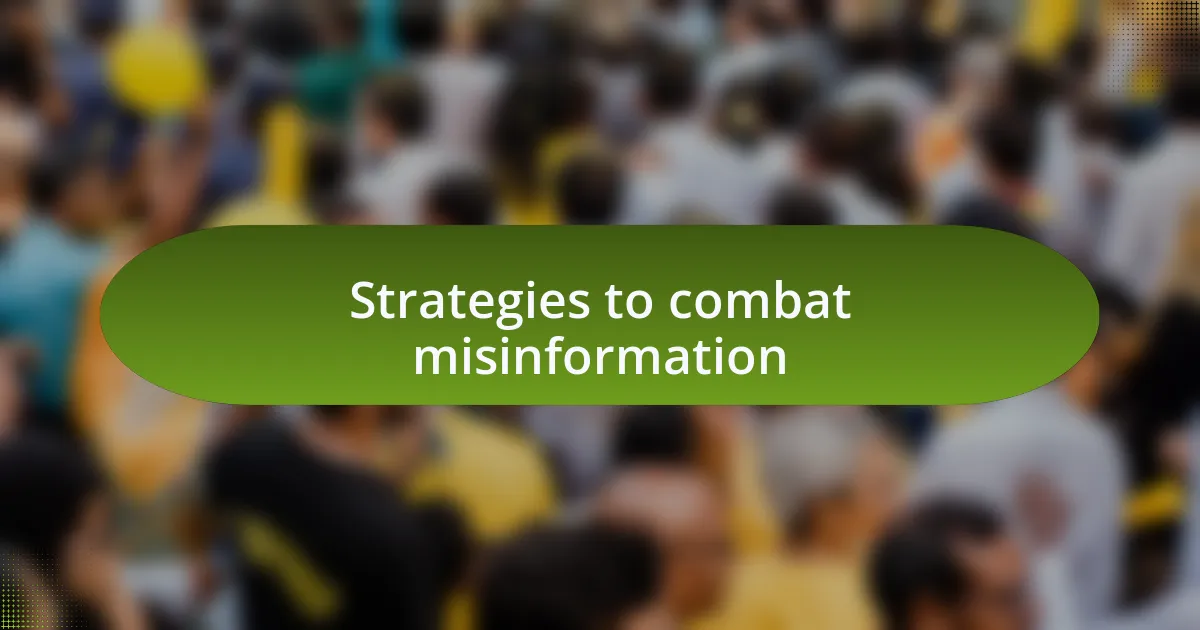
Strategies to combat misinformation
One effective strategy I’ve found is to always cross-check information from multiple reputable sources before sharing it. I remember reading an article that seemed sensational, but rather than hitting the share button impulsively, I took a moment to verify the claims. This pause not only bolstered my credibility but also ensured I wasn’t spreading falsehoods. Imagine how many arguments could be avoided if we all took this extra step.
Another approach I’ve adopted is discussing misinformation openly with friends and family. I recall a heated dinner conversation where misinformation had crept into our dialogue. Instead of arguing, I suggested we look up the claims together. This collaborative effort not only clarified the misconceptions but also reinforced our collective commitment to truth. How often do we think of these discussions as opportunities for learning rather than just debates?
Lastly, I believe in the power of education, especially when it comes to digital literacy. In one community workshop I attended, the facilitator emphasized recognizing persuasive techniques often used in misinformation, like emotional appeals. Understanding these tactics has since empowered me to critically analyze the content I encounter. It’s a vital skill—one that prompts the question: how can we better equip ourselves and others to navigate the increasingly complex media landscape?
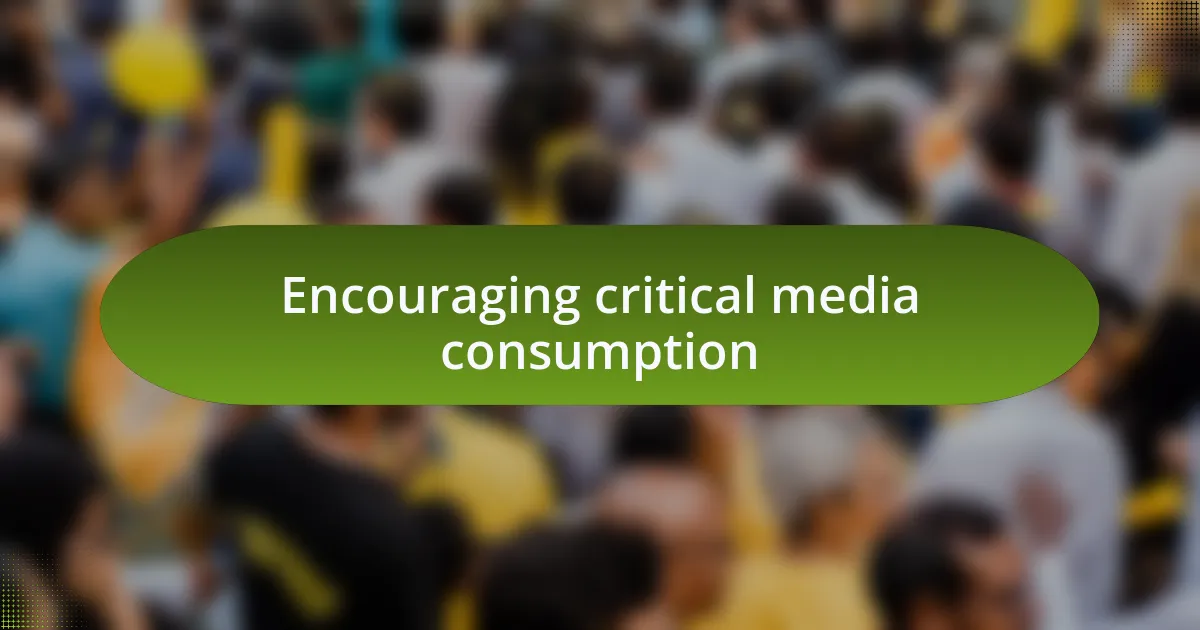
Encouraging critical media consumption
Cultivating a habit of questioning what we consume is crucial in today’s media environment. I remember one time scrolling through social media and stumbling upon a post that claimed an outrageous statistic about political engagement. Rather than automatically accepting it as truth, I paused and asked myself, “What evidence supports this?” That simple question led me down a path of discovery—confirming the statistic was exaggerated, which deepened my understanding of the need for skepticism in content evaluation.
Engaging in discussions about media narratives can profoundly shape our perspectives. I recently participated in a community forum where we tackled recent news stories. The experience was enlightening; we shared our interpretations and challenged misunderstood information, prompting me to reflect on how easily misinformation can slip into our daily conversations. It made me wonder, have we become so comfortable with familiar narratives that we overlook critical analysis?
Moreover, I find it empowering to utilize tools that enhance our media literacy. When I discovered fact-checking websites, it felt like finding a secret weapon. Before sharing an article, I now take the extra step to validate the claims against established databases. This practice not only protects my credibility but energizes my advocacy for truth in media. It leaves me thinking: if we all adopted this mindset, how much clearer and more informed could our public discourse become?